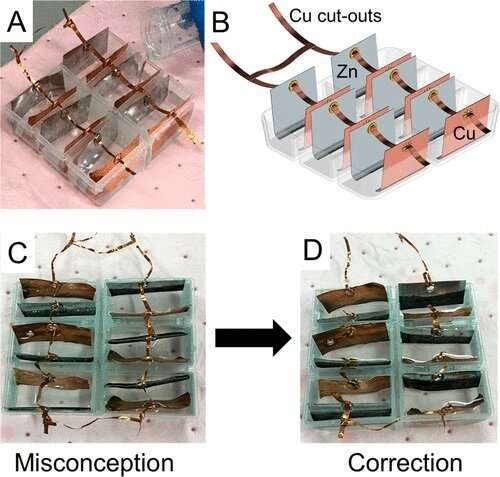A design-based activity to enhance students' understanding in electrochemistry

The electrochemistry designette is a purposefully developed design activity which allows students to demonstrate complex concepts and for instructors to impart a set of core skills to foster innovation. Developed by researchers from the Singapore University of Technology and Design (SUTD), this pedagogical tool was first introduced and published in 2019. It now has proven to be highly effective in allowing instructors to spot misconceptions in their students' understanding and provide prompt intervention.
Their study was published in the Journal of Chemical Education and featured on the cover page of its March 2022 issue.
A portmanteau of the words "design" and "charrette," a designette is a short, intense design-based activity that aims to spur interdisciplinary learning. In a designette, students, particularly those training in the fields of science, engineering, and architecture, project their understanding about a subject matter onto an open-ended design problem, generate potential solutions to the problem, and build prototypes using a given set of materials to validate these solutions.
In the electrochemistry designette, students are challenged to build a voltaic device that can turn on as many light-emitting diodes on a breadboard as possible. The materials provided in the designette, coupled with the intentional phrasing of the design problem, encourages students to derive several potential solutions as opposed to being fixated on a single solution.
The electrochemistry designette was initially conceived to allow instructors to measure students' competence and creativity through a series of objective metrics. However, the design team unintentionally found out that the designette also helps instructors visualize students' competence and misconceptions on electrochemical principles during the students' assembling of a voltaic device. This enables instructors to quickly discuss, clarify, and correct pivotal concepts synchronously.
"The benefits of hands-on learning to students notwithstanding, the electrochemistry designette also makes student comprehension and misconceptions visible to instructors through the medium of physical prototypes, thereby supporting instructors' teaching since it allows one to see concepts or ideas that may have otherwise been misunderstood," explained first author Vanessa Chia, an undergraduate from the Engineering Product Development pillar at SUTD.
Over 400 students have participated in the studies and proved to have benefitted from the designette. As a result of their success, both the electrochemistry designette and the OCP designette, a derivative hands-on activity, have since been implemented in the classrooms at SUTD as part of a series of hands-on activities offered in ILP2 Chemistry, 10.011 Introduction to Physical Chemistry and 10.016 Science for a Sustainable World courses.
While the research team is looking to extend their work on the electrochemistry designette under different cultural contexts to identify cultural sensibilities associated with this tool, they hope this latest development paves the way for a superior experiential learning experience for students across all university and pre-university levels.
"We would like to make the designette more widely available to students in Singapore, especially at the junior college and polytechnic levels, to better visualize misconceptions and to effectively measure students' performance," said principal investigator Dr. Franklin Anariba, who is also a lecturer from the Science, Mathematics and Technology cluster at SUTD.
"Moving forward, we would also like to adapt the designette into an educational kit which can be used remotely for synchronous and asynchronous lessons settings," he added.
More information: Vanessa Y. Y. Chia et al, Using the Electrochemistry Designette to Visualize Students' Competence and Misconceptions on Electrochemical Principles, Journal of Chemical Education (2022). DOI: 10.1021/acs.jchemed.1c00773
Journal information: Journal of Chemical Education
Provided by Singapore University of Technology and Design





















